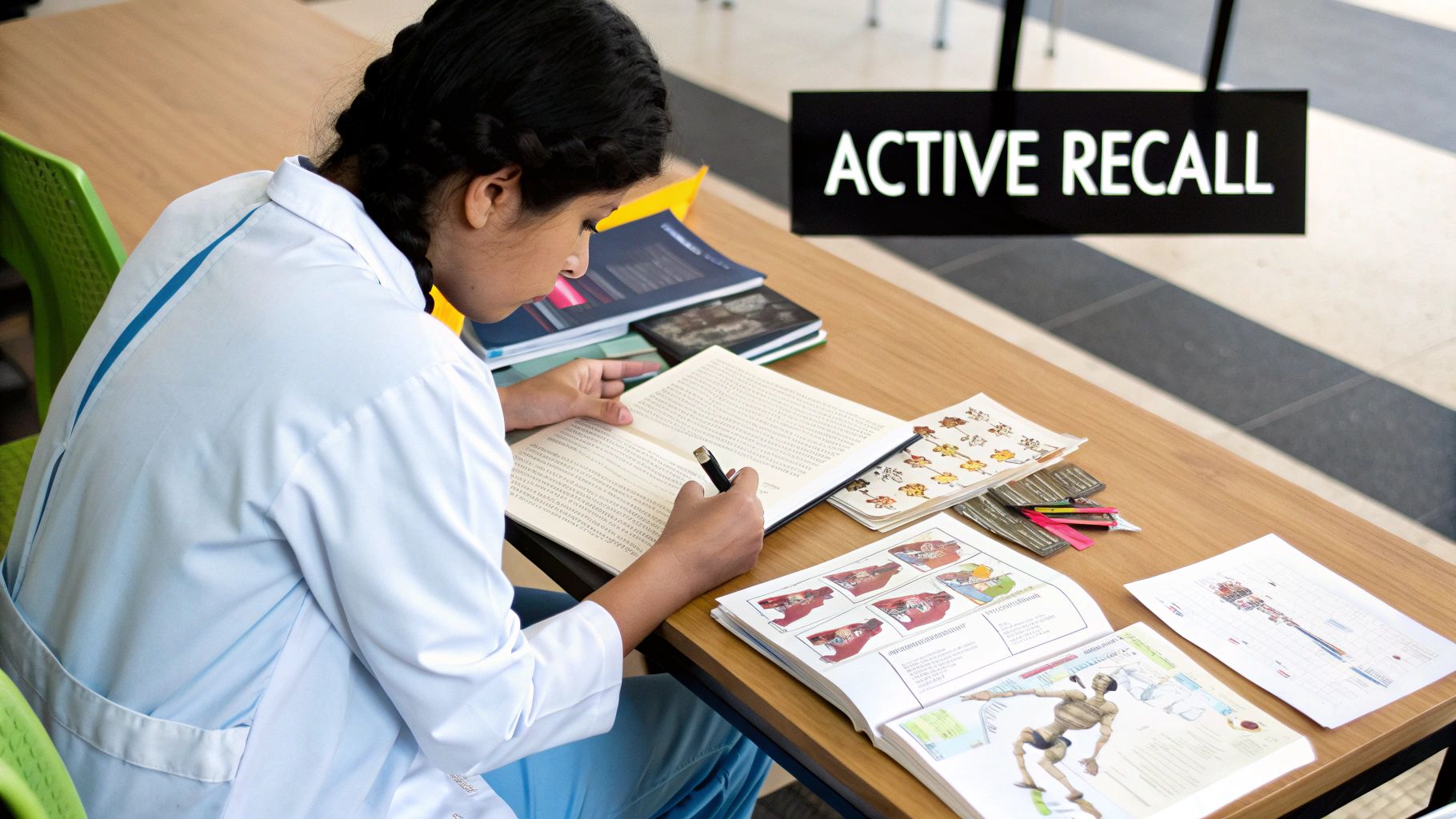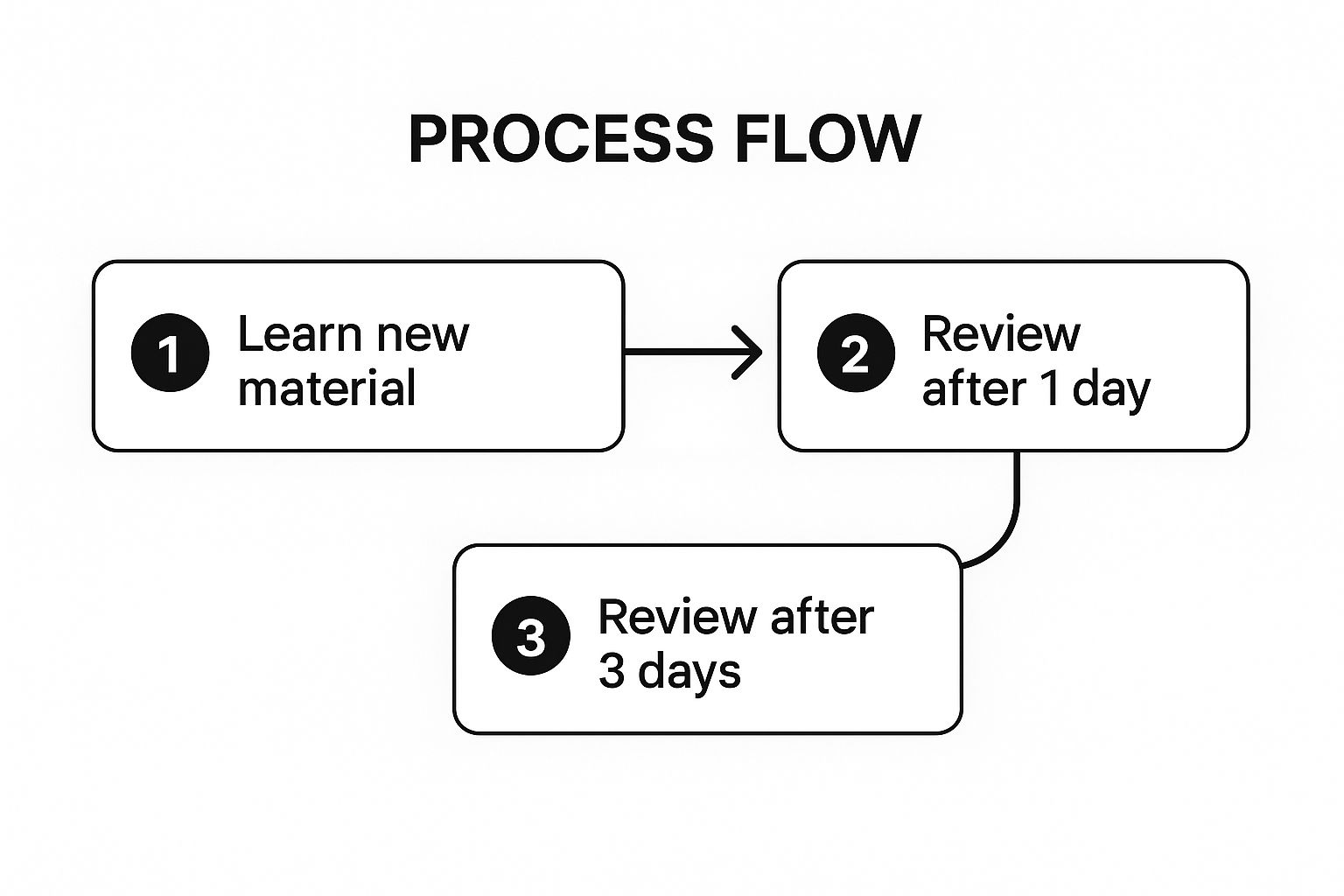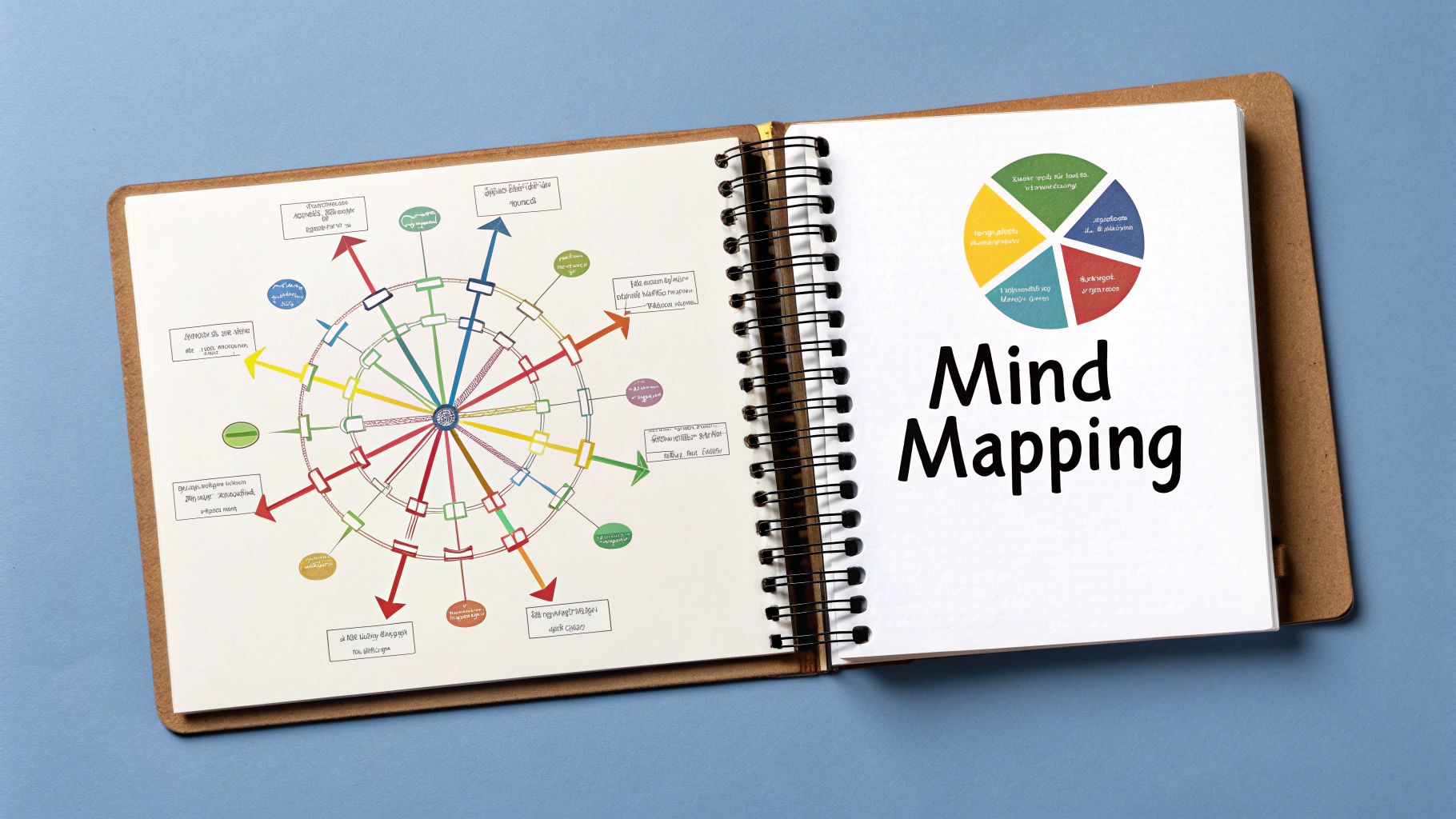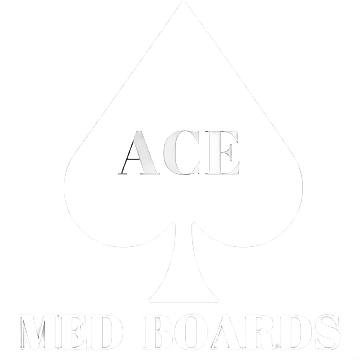Medical school is often described as trying to drink from a firehose. The sheer volume of information, from biochemistry pathways to clinical pharmacology, is staggering. Simply memorizing facts is not a sustainable or effective strategy, especially when preparing for high-stakes exams like the USMLE Steps, COMLEX Levels, or third-year shelf exams. The goal isn't just to pass; it's to build a deep, interconnected knowledge base that will serve you throughout your clinical rotations and your entire career as a physician.
This guide moves beyond generic advice to provide a curated list of powerful, evidence-based learning strategies. These are not just abstract theories; they are actionable medical student study tips designed to help you study smarter, not just harder. We will explore specific techniques that force your brain to actively engage with the material, build lasting recall, and connect disparate concepts into a coherent clinical picture.
Instead of relying on passive review and rote memorization, you will learn how to:
- Actively retrieve information to strengthen memory traces.
- Strategically space out your review sessions for maximum long-term retention.
- Break down complex topics into simple, teachable concepts.
Each tip in this article includes practical implementation details and real-world examples tailored to the medical curriculum. Whether you are a first-year student grappling with anatomy or a resident preparing for Step 3, these methods will help you conquer the information overload, excel on your board exams, and develop the critical thinking skills essential for modern medicine. Let's dive into the strategies that will help you crack the code of medical education.
1. Active Recall
Active recall is a cornerstone of evidence-based learning and one of the most powerful medical student study tips you can implement. Instead of passively reviewing notes, reading textbooks, or watching lectures, active recall forces your brain to actively retrieve information from memory. This process of “pulling out” knowledge, rather than “putting it in,” strengthens the neural connections associated with that memory, making it far more durable and easier to access during a high-stakes exam like the USMLE or a Shelf exam.

Popularized by the research of cognitive psychologists like Henry Roediger III and Jeffrey Karpicke, this technique fundamentally changes how you interact with study material. Passive review creates a false sense of familiarity; you recognize the material on the page and assume you know it. Active recall shatters this illusion by forcing you to prove you can generate the information yourself, which is exactly what you must do on test day.
How to Implement Active Recall
Integrating active recall into your study routine doesn't require a complete overhaul, just a shift in methodology. The goal is to move from being a consumer of information to a producer of it.
- Flashcards (Digital or Physical): This is the classic example. Use software like Anki to create digital flashcards for everything from anatomical structures to drug mechanisms. The key is to force yourself to answer before flipping the card.
- Practice Questions: After covering a topic, immediately dive into practice questions from a question bank (Qbank) like UWorld or Amboss. Do these questions closed-book, simulating exam conditions.
- The Feynman Technique: Try to explain a complex concept, like the renin-angiotensin-aldosterone system, to a colleague or even just to a blank wall. Teaching forces you to retrieve, organize, and simplify information, exposing gaps in your understanding.
- Brain Dumps: After a lecture or reading a chapter, close your book and write down everything you can remember about the topic on a blank sheet of paper. Then, compare your notes to the source material to identify what you missed.
Key Insight: Active recall feels harder than passive review because it is. This mental effort is not a sign of failure; it is the very mechanism that builds strong, lasting memories. Embrace the struggle, as it's a sign that effective learning is happening.
For medical students facing an overwhelming volume of information, active recall is not just a study tip; it is a survival strategy. It ensures that the time you spend studying translates into knowledge you can actually use under pressure, whether you are on the wards, taking a COMLEX exam, or sitting for your board certification.
2. Spaced Repetition
Working in tandem with active recall, spaced repetition is an evidence-based learning technique that combats the natural human tendency to forget information over time. This method involves reviewing material at increasing intervals, strategically interrupting the "forgetting curve" just as a memory begins to fade. For medical students tasked with memorizing a seemingly infinite amount of information, from biochemical pathways to pharmacology, this is one of the most critical medical student study tips for building durable, long-term knowledge.

Pioneered by the research of Hermann Ebbinghaus and later operationalized by software developers like Piotr Wozniak (SuperMemo) and Damien Elmes (Anki), spaced repetition is the antidote to cramming. Instead of massed practice (reviewing a topic intensely in one session), you revisit information periodically. Each successful review strengthens the memory trace and tells your brain that this information is important, which progressively extends the time until the next review is necessary.
How to Implement Spaced Repetition
The most effective way to integrate spaced repetition is through dedicated software that automates the scheduling process, freeing you up to focus on the material itself.
- Use a Spaced Repetition System (SRS): The most popular SRS in medical education is Anki. Create digital flashcards for facts, concepts, and clinical vignettes. The software's algorithm will automatically schedule when you need to see each card again based on how easily you recalled it.
- Be Consistent: The system only works if you use it. Commit to reviewing your scheduled cards every single day. Missing even one day can lead to a backlog that becomes difficult to manage and disrupts the algorithm's effectiveness.
- Create High-Quality Cards: Your cards should be atomic, meaning they test one discrete piece of information. Use images, screenshots from lectures, and mnemonics to make cards more memorable and provide context.
- Start Immediately: Begin making and reviewing cards the same day you learn new material in a lecture or from a Qbank. This ensures the information is captured in your SRS before you have a chance to forget it.
Key Insight: Spaced repetition transforms studying from a frantic, short-term activity into a sustainable, long-term process. Trust the algorithm; it is designed to show you what you need to see, precisely when you need to see it, maximizing your retention with minimum effort over time.
For any student facing high-volume exams like the USMLE or COMLEX, spaced repetition is non-negotiable. It is the framework that allows you to manage the vast curriculum, moving critical knowledge from your fragile short-term memory into reliable long-term storage, ready for recall on exam day and beyond. Learn more about the specific strategies for using spaced repetition in medical school.
3. Feynman Technique
The Feynman Technique is a powerful mental model for learning that prioritizes true comprehension over rote memorization. Named after Nobel laureate physicist Richard Feynman, this method challenges you to deconstruct a complex topic into its most fundamental principles and explain it in simple, clear language. For medical students drowning in jargon and intricate pathways, this technique is an indispensable tool for building a deep, lasting understanding of medicine that goes far beyond surface-level recall.
The premise is simple: you don't truly understand something until you can explain it to someone who has no prior knowledge of the subject, like a child or a non-medical friend. This process forces you to move past memorized buzzwords and confront the "why" and "how" behind every concept. When you are forced to use simple analogies and basic terms, you quickly expose any gaps in your own knowledge, which you can then target for review.
How to Implement the Feynman Technique
Integrating the Feynman Technique is about adopting a "teach to learn" mindset. It's an active process that requires you to engage with the material on a much deeper level than passive reading.
- Explain it to a Layperson: Choose a complex topic, like the pathophysiology of diabetic ketoacidosis or the cardiac cycle. Try to explain it out loud to a friend or family member with no medical background. Pay attention to where you stumble or have to resort to complex terminology.
- Use Analogies and Diagrams: Simplify intimidating subjects by relating them to everyday life. For instance, explain pharmacokinetics using the analogy of a package being delivered, processed, and eventually discarded. Draw simple flowcharts and diagrams on a whiteboard or piece of paper to visualize the process as you talk.
- Identify and Fill Gaps: The moment you get stuck or say "I don't know," you've found a weak point. Go back to your source material (textbooks, lecture notes, or resources like Amboss) to clarify that specific point. Then, refine your explanation until it is smooth and simple.
- Record Yourself: Use your phone to record yourself "teaching" a concept. Listening back is a powerful way to self-assess your clarity, confidence, and mastery of the material. It makes any hesitation or confusion immediately obvious.
Key Insight: The Feynman Technique is the ultimate test of understanding. If you cannot explain a concept simply, you haven't fully learned it. The struggle to simplify is where deep learning occurs, solidifying knowledge for exams and, more importantly, for clinical practice.
For medical students, this is one of the most effective study tips because it directly translates to the wards. You will constantly be asked to explain conditions and treatments to patients in easy-to-understand terms. Mastering the Feynman Technique not only helps you ace your exams but also builds the foundational communication skills of a great physician.
4. Pomodoro Technique
The Pomodoro Technique is a time management method that combats mental fatigue and enhances focus, making it one of the most practical medical student study tips for marathon study days. It involves breaking down your study sessions into focused, 25-minute intervals separated by short breaks. This cyclical approach, developed by Francesco Cirillo in the late 1980s, prevents the burnout that often accompanies long, unstructured hours of studying subjects like pathology or pharmacology.

This technique works by creating a sense of urgency and structure. Knowing you only have a 25-minute window to focus on a specific task, like reviewing a set of microbiology flashcards, encourages you to eliminate distractions and work with high intensity. The built-in breaks act as a mental reset, improving your ability to maintain concentration over a much longer period. This structured work-rest cycle helps you push through the sheer volume of information without hitting a wall of exhaustion.
How to Implement the Pomodoro Technique
Integrating this method into your study schedule is straightforward and requires nothing more than a timer. The goal is to train your brain to work in focused sprints, making your study time more efficient and less daunting.
- Set Your Timer for 25 Minutes: Choose one task, such as reading a chapter in a medical textbook or completing a block of practice questions, and work on it without interruption until the timer rings.
- Take a 5-Minute Break: When the timer goes off, step away from your desk. Stretch, grab a drink of water, or walk around your room. Avoid checking your phone or email, as this can pull you out of your study mindset.
- Repeat the Cycle: Complete four "Pomodoros" (25-minute work sessions) back-to-back, with a 5-minute break after each one.
- Take a Longer Break: After four consecutive Pomodoros, reward yourself with a longer break of 15-30 minutes. This is a good time to have a snack, listen to some music, or do something completely unrelated to medicine to fully recharge before your next set of sessions.
Key Insight: The Pomodoro Technique is not just about time management; it's about energy management. By intentionally scheduling short breaks, you preserve your mental energy, allowing for sustained high-quality focus over many hours, which is essential for tackling comprehensive exams like the USMLE or COMLEX.
For medical students who find their attention waning during long study blocks, the Pomodoro Technique offers a powerful framework to stay on task and be productive. It transforms an overwhelming eight-hour study day into a manageable series of focused sprints, ultimately improving both retention and well-being. To dive deeper into structured study schedules, you can explore additional time management tips for medical students.
5. Mind Mapping
Mind mapping is a powerful visual learning technique that can transform how you organize and retain complex medical information. Instead of linear, text-based notes, mind mapping uses a hierarchical, radial structure that radiates outward from a central concept. This method engages both the creative and logical sides of your brain, making it one of the most effective medical student study tips for understanding intricate relationships between physiological systems, disease pathologies, and treatment algorithms.

Popularized by author and educational consultant Tony Buzan, this technique mirrors the brain's natural way of thinking: through association. For a medical student, this means you can visually link a single disease, like diabetes mellitus, to its pathophysiology, clinical presentation, diagnostic criteria, and various classes of pharmacological treatments all on one page. This holistic view helps build meaningful connections that are easier to recall under the pressure of a board exam or during clinical rounds.
How to Implement Mind Mapping
Integrating mind mapping into your study workflow is about visualizing connections rather than just memorizing lists. It’s a creative process that solidifies knowledge by building a conceptual framework.
- Map Complex Systems: Use a large sheet of paper or a digital app to map out entire organ systems. Start with "Cardiovascular System" in the center and branch out to anatomy (chambers, valves), physiology (cardiac cycle, ECG), pathology (ischemic heart disease, heart failure), and pharmacology (beta-blockers, ACE inhibitors).
- Create Disease Pathways: Choose a specific disease, such as Crohn's disease, and place it at the center. Create main branches for Epidemiology, Pathophysiology, Clinical Features, Diagnosis, and Management. Then, add smaller sub-branches with specific details like "skip lesions" or "anti-TNF agents."
- Organize Pharmacology: Instead of memorizing drug lists, create a mind map for a drug class like "Antibiotics." Main branches could be mechanisms of action (cell wall synthesis inhibitors, protein synthesis inhibitors), with sub-branches for specific drugs and their spectrum of coverage.
Key Insight: A mind map’s true power lies in its creation. The act of organizing the information, deciding on the hierarchy, and drawing the connections is a potent form of active learning. The final map is not just a study guide; it is a visual record of your own understanding.
For students overwhelmed by the sheer volume of facts in medicine, mind mapping provides a lifeline. It transforms fragmented data points into an interconnected web of knowledge, ensuring you don't just know the facts, but you understand how they relate to each other, a critical skill for both exams and clinical practice.
6. Case-Based Learning (CBL)
Case-Based Learning (CBL) moves beyond rote memorization by grounding medical knowledge in the context of real-world patient scenarios. This powerful educational approach presents you with a clinical vignette, complete with a patient's history, symptoms, and lab results, and challenges you to work through the diagnostic and management process. It directly mirrors the practice of medicine, forcing you to integrate disparate facts from pathology, pharmacology, and physiology to solve a tangible clinical problem.
Pioneered by institutions like Harvard and McMaster University, CBL is not just an academic exercise; it is the fundamental structure of USMLE and COMLEX board questions. Learning to deconstruct a clinical case is one of the most high-yield medical student study tips because it trains the exact clinical reasoning skills you need for your exams and, more importantly, for your future patients. It transforms abstract knowledge into a functional diagnostic toolkit.
How to Implement Case-Based Learning
Effectively integrating CBL means actively engaging with clinical problems rather than just reading about them. The goal is to develop a systematic approach to every patient presentation you encounter.
- Deconstruct Question Bank Vignettes: Don't just answer a UWorld or Amboss question and move on. After each one, break down the case: Who is the patient (age, sex, comorbidities)? What is the chief complaint? What are the key positive and negative findings? Build a differential diagnosis before you even look at the answer choices.
- Work in Groups: Discussing cases with peers is an excellent way to see different perspectives. One person may pick up on a subtle clue in the history that another missed. This collaborative process mimics the team-based environment of a hospital and strengthens everyone's reasoning skills.
- Create Your Own Cases: A powerful way to master a topic is to write a clinical vignette for it. For example, if you're studying Cushing's syndrome, create a classic patient presentation. This forces you to think about which symptoms, exam findings, and lab values are most indicative of the disease.
- Follow Real Patient Presentations: On your clinical rotations, "own" your patients' cases. Follow their labs, imaging, and progress day by day. Try to anticipate the next steps in their management and discuss your reasoning with residents and attendings. For a deeper dive into how to apply this and other methods, explore these study techniques for med students on acemedboards.com.
Key Insight: The answer to a case is less important than the process you took to get there. Focus on building a robust differential diagnosis and justifying your reasoning for each step. This process-oriented mindset is what separates top-performing students and competent future physicians.
For medical students, CBL is the bridge between the preclinical and clinical years. It trains you to think like a doctor by asking the right questions, identifying key patterns, and applying your foundational knowledge to solve complex patient problems, a skill that is essential for both board exams and a successful medical career.
7. Interleaving
Interleaving is a powerful learning strategy that challenges the traditional approach of studying one topic to completion before moving to the next. Instead of dedicating an entire study block to cardiology (blocked practice), interleaving involves mixing different topics or problem types within a single session. This method forces your brain to constantly switch gears, which improves your ability to differentiate between similar concepts and select the correct problem-solving strategy, a critical skill for board exams and clinical practice.
Pioneered by cognitive psychologists like Robert Bjork, interleaving enhances long-term retention and the ability to transfer knowledge to new situations. While blocked practice can create a temporary feeling of mastery, it poorly prepares you for the reality of an exam where questions from different subjects are jumbled together. Interleaving mimics this exam environment during your study sessions, making you more adaptable and less likely to freeze when faced with an unexpected question. This approach is a key component of effective medical student study tips for building flexible, durable knowledge.
How to Implement Interleaving
Adopting interleaving requires a shift from marathon-style, single-topic sessions to a more dynamic, mixed approach. The goal is to create desirable difficulties that strengthen your ability to recall and apply information in varied contexts.
- Mix Your Qbank Sessions: When creating a block of practice questions in UWorld or Amboss, select multiple systems (e.g., Cardiology, Pulmonology, and Renal) instead of just one. This forces you to identify the organ system and relevant pathology for each question from scratch.
- Alternate Between Subjects: Structure your study time to alternate between different subjects. For example, spend 25 minutes on pharmacology, followed by 25 minutes on microbiology, and then 25 minutes on anatomy, rather than three hours straight on pharmacology.
- Vary Problem Types: Within a single topic like cardiology, interleave different types of problems. Mix practice questions about ECG interpretations, heart murmur identification, and antihypertensive drug mechanisms instead of mastering each one in isolation.
- Plan Your Mix: Before starting, create a simple schedule for your session. For example: 5 cardiology questions, 5 neurology questions, 5 GI questions, and then repeat the cycle. This prevents you from defaulting to what feels comfortable.
Key Insight: Interleaving will feel less productive and more difficult than blocked practice in the short term. You might get more questions wrong initially. This is a feature, not a bug. The mental effort required to switch between topics is what builds the cognitive flexibility that leads to superior long-term performance.
For medical students who must master an enormous, interconnected web of information, interleaving is more than just a technique; it's a way to build a more functional and resilient knowledge base. It trains your brain to see the connections and distinctions between different fields of medicine, preparing you not just for exams, but for the complex diagnostic challenges you'll face as a physician.
7 Effective Study Strategies Comparison
| Technique | Implementation Complexity 🔄 | Resource Requirements ⚡ | Expected Outcomes 📊 | Ideal Use Cases 💡 | Key Advantages ⭐ |
|---|---|---|---|---|---|
| Active Recall | Medium – requires self-discipline and time investment | Low – flashcards or practice questions | Strong long-term retention, knowledge gap identification | Memorization-heavy subjects, exam prep | Highly effective for retention, builds exam confidence |
| Spaced Repetition | High – needs consistent daily practice and setup | Medium – software/tools like Anki | Maximizes retention with spaced reviews | Large volume content, subjects requiring durable memory | Efficient retention with minimal daily time, reduces anxiety |
| Feynman Technique | Medium-High – time-intensive and may need partners | Low – just explanation tools or partners | Deep comprehension, reveals knowledge gaps | Complex concepts, teaching and communication practice | Ensures true understanding, improves communication skills |
| Pomodoro Technique | Low – easy interval timing setup | Low – timer or app | Improved focus and reduced burnout | Managing study time, preventing fatigue | Boosts concentration, manageable workload via breaks |
| Mind Mapping | Medium-High – time-consuming to create detailed maps | Low-Medium – pen/paper or software | Enhances visual memory and concept connections | Visual learners, complex interrelated content | Encourages creative thinking, visualizes relationships |
| Case-Based Learning | High – needs extensive case materials and prep | High – case libraries, group work | Improves clinical reasoning and problem-solving | Clinical learning, applying theory to practice | Develops critical thinking, connects theory to real cases |
| Interleaving | Medium – requires careful planning and mixed content | Low – flexible with existing materials | Improves discrimination and flexible problem solving | Comprehensive exam prep, varied subject study sessions | Enhances long-term retention, promotes flexible thinking |
Putting It All Together: Your Personalized Study Blueprint
Navigating the relentless torrent of information in medical school can feel like trying to drink from a fire hose. The sheer volume is daunting, the stakes are incredibly high, and the pressure is constant. However, the path to mastering this material isn't about brute force memorization or spending every waking moment chained to your desk. As we've explored, success hinges on a smarter, more strategic approach to learning. The collection of medical student study tips detailed in this article are not just abstract theories; they are battle-tested, evidence-based tools designed to transform how you engage with complex medical concepts.
The journey through medical education is a marathon, not a sprint. The key is to build a sustainable, efficient, and personalized system that works for you. This means moving beyond passive learning habits like re-reading textbooks or highlighting notes, which often create a false sense of familiarity without true comprehension. Instead, the focus must shift to active, effortful learning.
Synthesizing Your Strategy: From Theory to Practice
The most powerful takeaway is that these techniques are not mutually exclusive. Their true potential is unlocked when you combine them into a cohesive, personalized study blueprint. Think of Active Recall, Spaced Repetition, and the Feynman Technique as the foundational pillars of your learning architecture.
- Active Recall is your primary tool for forging strong neural pathways. It forces your brain to retrieve information, which is the most effective way to strengthen memory.
- Spaced Repetition is the scheduler that optimizes those recall sessions, ensuring you review material at the perfect intervals to combat the forgetting curve and achieve long-term retention.
- The Feynman Technique acts as your quality control, a diagnostic tool to expose gaps in your understanding before you walk into an exam.
Layered on top of this foundation are the tactical methods that structure your daily efforts. The Pomodoro Technique provides the framework for maintaining intense focus and preventing burnout, breaking down overwhelming study blocks into manageable, high-intensity sprints. Mind Mapping and Case-Based Learning (CBL) offer powerful ways to visualize connections and apply knowledge in a clinical context, which is essential for both board exams and real-world practice. Finally, Interleaving challenges your brain to become more flexible, improving your ability to differentiate between similar conditions-a critical skill for acing multiple-choice questions on Shelf and USMLE/COMLEX exams.
Your Actionable Next Steps
Creating your custom study plan doesn't have to be complex. Start small and build momentum.
- Choose One Technique to Master: Don't try to implement everything at once. Pick one method that resonates with you-perhaps starting with the Pomodoro Technique to structure your time or Active Recall with flashcards for a specific subject.
- Integrate and Iterate: Once you're comfortable, begin layering in another technique. For example, use your Pomodoro sessions to create flashcards (Active Recall) and schedule them in a Spaced Repetition System (SRS) app.
- Audit Your Understanding: Regularly use the Feynman Technique to check your knowledge. Can you explain the renin-angiotensin-aldosterone system to a friend without looking at your notes? If not, that's your signal to dive deeper.
- Prioritize Your Well-being: The intensity of medical school studying places immense strain not just on your mind, but on your body. Long hours staring at screens can lead to significant discomfort and reduced productivity. It's crucial to learn how to reduce eye strain by taking regular breaks, adjusting your screen settings, and ensuring proper lighting. Protecting your physical health is a non-negotiable component of any effective study plan.
Ultimately, the most effective set of medical student study tips is the one you consistently use. Your journey is unique, and your study methods should reflect that. Experiment, adapt, and refine your approach until you have a system that not only helps you excel on your exams but also builds a deep, lasting foundation of medical knowledge that will serve you throughout your entire career as a physician.
If you're looking for a structured way to implement these high-yield strategies, consider the resources from Ace Med Boards. Our programs are specifically designed to integrate principles like active recall and case-based learning to help you master content for the USMLE and COMLEX exams. Visit Ace Med Boards to see how our targeted approach can elevate your board preparation.

